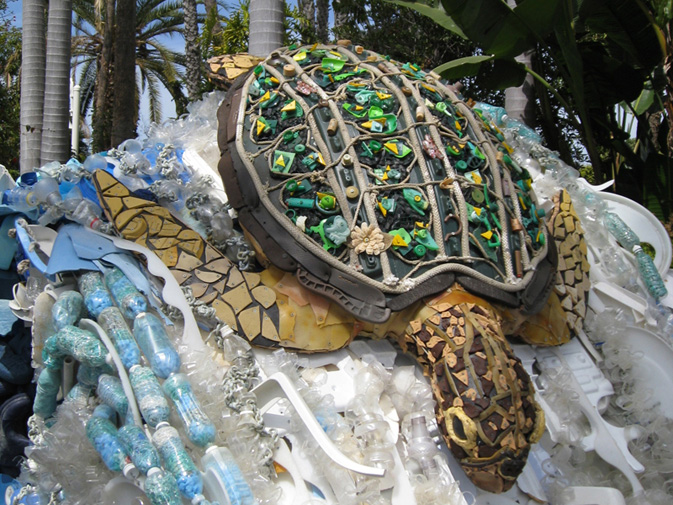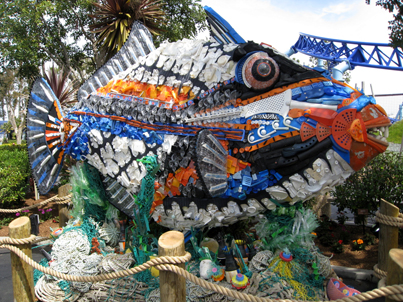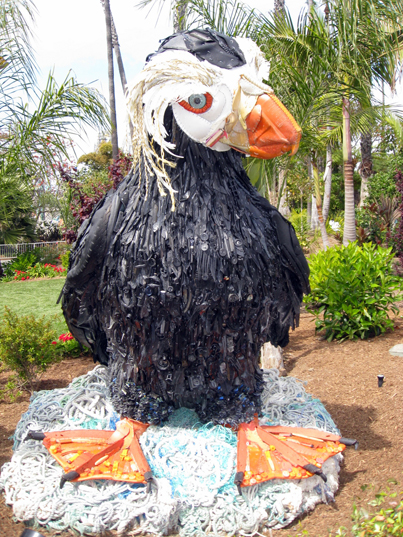
A giant sculpture of a sea turtle by The Washed Ashore Project, made entirely of beach trash, at SeaWorld San Diego. Sea turtles often mistake floating plastic bags for jellyfish and eat them.
Art can send a powerful message, but can it save the sea?

A giant sculpture of a trigger fish by The Washed Ashore Project, made entirely of beach trash, at SeaWorld San Diego. Fish can become strangled, entangled or injured from the ingestion of plastic.
If you’ve ever stood on a beach looking out at the ocean, it might be hard to imagine that something so powerful can be so fragile. But pollution, overfishing and global warming are taking their toll on ocean habitats.
We reduce, reuse, repurpose and recycle — but we don’t always have a context for why we’re doing it.
During a recent press trip to SeaWorld San Diego for the marine park’s 50th anniversary celebrations, I was immediately drawn to a sculpture of a sea turtle. As I got closer, I realized the entire sculpture was made of garbage — water bottles, fishing nets, nylon ropes and even a plastic beach chair.
I was amazed by the creativity behind this — and horrified by all that garbage.
It’s no coincidence the artist chose to turn that garbage into a sea turtle. Turtles eat jellyfish and, to a turtle, a floating plastic bag looks an awful lot like a jellyfish. And there are a lot of plastic bags floating around in the ocean.
In fact, tons of garbage ends up in the ocean every day, and marine animals often mistake this debris for food. Turtles, fish, whales, seals and sea birds can become strangled, entangled or injured from ingesting plastics and other garbage.
Environmental art group The Washed Ashore Project is an Oregon-based non-profit that aims to educate and create awareness of marine debris and plastic pollution through art.

A giant sculpture of a tufted puffin by The Washed Ashore Project, made entirely of beach trash, at SeaWorld San Diego. Tufted puffins can become entangled in forgotten nets, ropes and fishing line.
Under the guidance of artist Angela Haseltine Pozzi, thousands of community volunteers collect garbage that washes up on beaches, process it into art supplies and construct giant sculptures of the sea life most affected by plastic pollution.
Over the past three years, they’ve collected more than 10 tons of garbage — and 95% of it is petroleum based.
The world produces 300 million pounds of plastic every year and less than 10% of it is recycled. Through this project, at least some of that plastic is transformed into educational art projects, rather than floating around in our oceans.
For its 50th anniversary, SeaWorld commissioned a series of giant sea life sculptures to The Washed Ashore Project, which are currently on exhibit at all three SeaWorld locations.
Considering that millions of people pass through the gates of SeaWorld parks, it’s a great way to educate the general public — kids and adults — about the urgent need to protect and preserve ocean habitats.
And it’s an effective way to do it. The giant sculptures draw you in, but it’s hard not to feel shocked when you get up close and see what they’re actually made of.
Art might not save the world, but it can help. It’s a reminder that something as simple as picking up that piece of garbage you see lying on the beach can make a difference. It’s a small act — but it could save a turtle’s life
